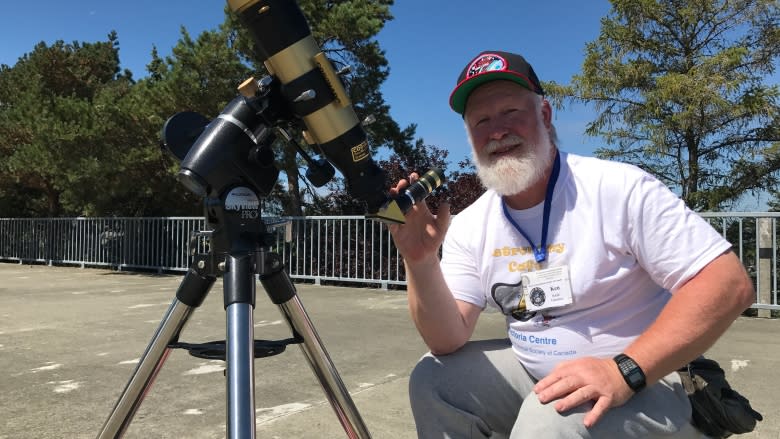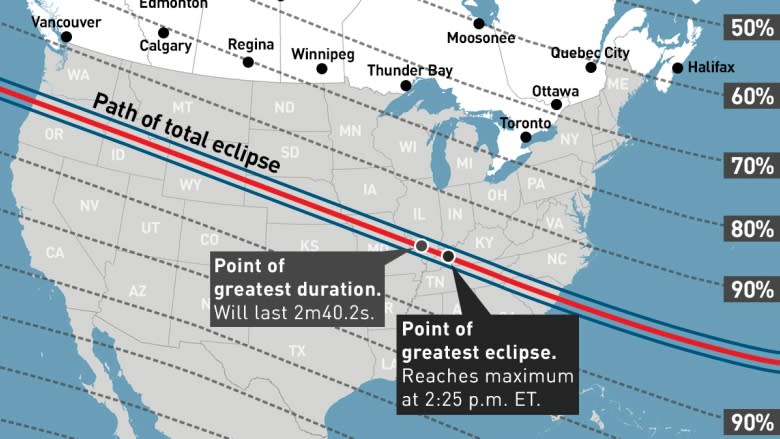'Day and night': Partial eclipse won't bring awe of totality to B.C., but still promises to impress
If the frenzy ahead of Monday's total solar eclipse has you thinking about trying to see it for yourself, you're a little late.
Vancouver ecologist Marlow Pellatt started a year ago, looking for a place to camp in Oregon in the "path of totality", which will turn day to night for two minutes and a few seconds in the morning.
Even then, campgrounds were gone.
"Even though we thought we were planning far ahead, it wasn't far ahead compared to what some folks are doing," said Pellatt from the Oregon coast, en route to Madras, Ore.
They did find something, renting a plot in a field about the size of two parking spots, which they'll call home awaiting the main event along with 30,000 others expected in the small town, usually home to just under 7,000 people.
Worth it, he says, for a natural phenomenon people call life-changing.
"We expect once the crowds start to converge, we won't be going anywhere for five days."
But if you're not one of the millions flocking to the first total solar eclipse to cross the continental U.S. in 99 years, fear not: all of Canada will still be treated to a partial eclipse Monday.
The good news is B.C. will get the biggest show, with a 90 per cent eclipse in Victoria and 86 per cent in Vancouver. The bad news is, astronomers will tell you: a total eclipse is something totally different.
Difference between day and night
The fact that total solar eclipses are even possible is a cosmic coincidence, says UBC astrophysicist Jaymie Matthews.
"We as humanity are the winners of the grand prize in a cosmic geometry lottery ... because it happens that our moon is 400 times smaller than our sun but it is 400 times closer."
Under a partial eclipse, the moon will move across our star, taking a bigger and bigger bite until a crescent of bright sun is all that remains.
In totality however, that daylight is gone.
"Just before the main event you'll see the moon's shadow racing toward you across the landscape. Then — totality," said Matthews, who has experienced two total solar eclipses, in Hungary and South Africa.
Stars and even planets become visible in the twilight that moments ago, was a daytime sky. Birds grow quiet. The halo of light around the sun, known as the corona, becomes visible to the naked eye.
"For a solar eclipse, the difference between even 99.9 per cent and a hundred per cent is like the difference between day and night," said Matthews.
"Totality is the kind of experience which can even be addictive."
Partial eclipse still impressive
In B.C., the partial eclipse is still generating excitement, with events for the public held in Vancouver by the H.R. MacMillan Space Centre, Science World, and UBC, and many smaller viewing parties organized by astronomy enthusiasts.
Derek Kief, astronomer at the H.R. MacMillan Space Centre, says the sky will dim and depending on conditions, we may be able to see Venus or other planets.
"It will be a fantastic opportunity to have a look at our sky during a really cool celestial event."
In Victoria, Ken Mallory will be spending the eclipse at Mount Tolmie Park, one of the region's best lookouts, with his telescope equipped with a filter to watch safely.
He's fielded more than 100 calls already from people interested in joining him.
"You will notice a twilight ... you might even notice the birds stop singing," said Mallory, a member of the Royal Astronomical Society of Canada.
How and when to watch safely
The partial eclipse will begin on the B.C. coast at about 9:10 a.m. PT, with the moon reaching its maximum eclipse of the sun at about 10:21 a.m.
If you're not heading to an organized viewing party, look for somewhere where there's no tall buildings or other structures that might block the view.
"The big thing is you want to get to a place where you can see the sun usually in the early morning hours," said Kief, suggesting a field or other open area.
Because it's happening in the morning, the sun will be in the East and about 34 degrees above the horizon when the eclipse begins, around a third of the way up.
Eye protection is necessary: the sun's power may seem diminished, but the crescent of light can burn your eye's retina as quickly as the full disc.
If you haven't managed to grab eclipse viewing glasses, which are now sold out of most locations, you can make a pinhole camera to view the eclipse indirectly.
With files from CBC's Megan Thomas



